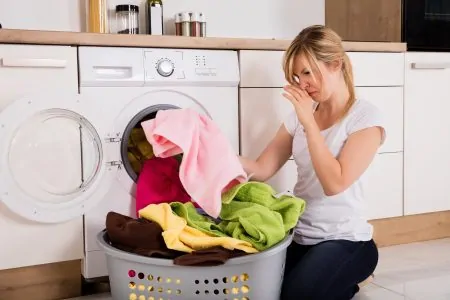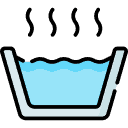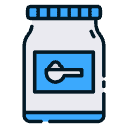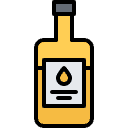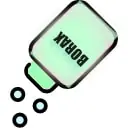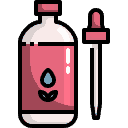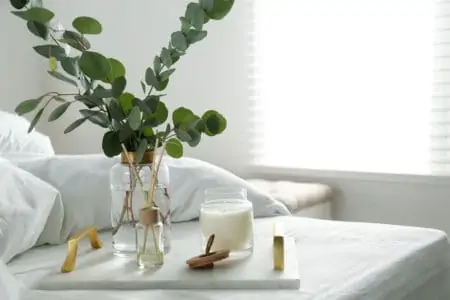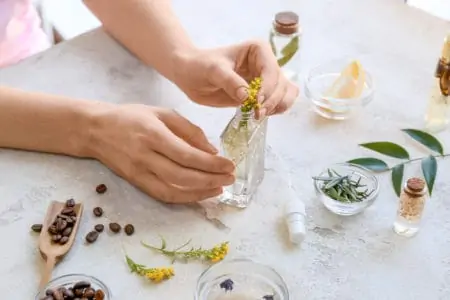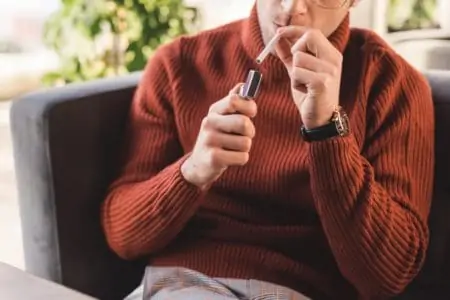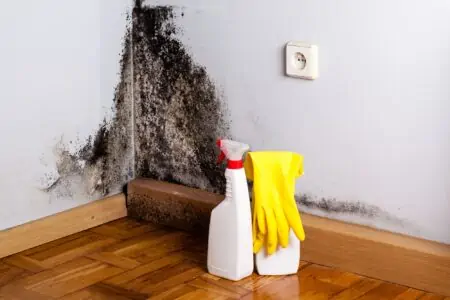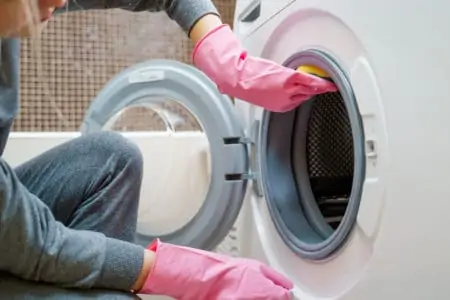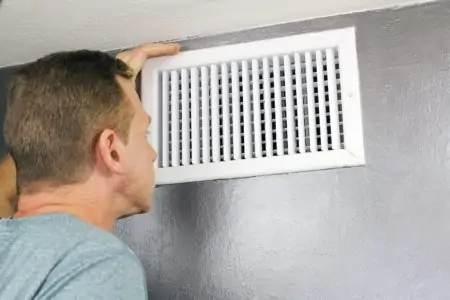Have you identified a musty odor and are wondering how to get rid of mold smell? This unpleasant aroma doesn’t go away easily, and spraying an air freshener will only help temporarily. Once you detect the odor, the key is to look for the mold colony.
Although spores aren’t causing the awful scent, they generally come as a package. Spores travel through the air and potentially into your lungs. Therefore, removing that mold smell isn’t only necessary for fragrance purposes but also to keep you and your family in good health.
Clearing mold isn’t as simple as a regular cleaning session; some precautions are required. We’ve outlined the best substances and techniques to eliminate mold smell to make the removal task faster.
Key Takeaways
- Mold smell is caused by microbial volatile organic compounds (MVOC) and can indicate a mold colony in your home.
- Mold spores can cause allergies, asthma, and other respiratory issues when inhaled.
- Natural mold-killing substances include hot water, hydrogen peroxide, baking soda, vinegar, borax, and essential oils.
- Cleaning techniques vary depending on the space or object, but proper ventilation and protective gear are important precautions to take.
What Does Mold Smell Like?
As you can’t always spot mold immediately (sometimes it’s thriving behind a wall or baseboard for months), the odor it produces is generally the first sign. Are you familiar with the smell of a wet swimming suit left in a bag? This is only one of the interesting scents mold can produce.
Typically, mold smells can be humid, sour, bitter, and fusty. While some species emit natural scents, others can have a sweet, fermenting, or alcohol-type aroma.
Even within the same species, odors can differ depending on their life cycle. Reproduction, growth, or even digestion can produce various malodorous aromas.
Simply put, if your garbage is out, mold should be considered an option when a lingering foul smell sticks around. Let’s just hope it doesn’t become a smell you get used to (1).
What’s Causing the Mold Smell?
Spores are mold seeds, responsible for its expansion and reproduction. Although often accused of creating a repulsive odor, spores aren’t usually the source of the smell. Mold is.
Mold produces microbial volatile organic compounds (MVOC), which are the root cause of a smelly home. Various MVOC — and, therefore, odors — are released throughout the bacteria’s development, digestion, and reproduction (2).
Is Mold Smell Harmful?
Mold spores are the ones guilty of causing us harm. These tiny particles range between three to 40 microns — a human hair isn’t thicker than 150 microns. They travel through the air and can be easily inhaled into our lungs, potentially causing allergies, asthma, and other respiratory conditions (3).
The strength of the smell is often unrelated to how dangerous the colony can be for our health. For instance, mold creates an incredible amount of spores during its reproductive cycle but very few MVOCs. This means that the odor will be mild, but spores will be present and very active.
Can I Use Air Fresheners?
When exposed to unpleasant odors, our first reaction might be to cover them up. You may even think you’ve solved your stinking issue. But the colony is still spreading, and the smell eventually comes back.
On another note, many air freshener manufacturers include chemicals detrimental to our well-being (4). So unless you’re using a natural product, you could be breathing more damaging compounds than with mold spores alone.
Since MVOCs and the resulting smells are produced by mold, the only long-term solution is to kill the fungus colony itself.
Precautions to Take
When you begin to tackle the smell, there are a few precautions worth taking. These steps will help to protect your lungs and prevent further spore infestation:
- Wear a mask: To avoid breathing mold spores, we advise wearing a mouth mask.
- Protective glasses: The fungus can cause eye irritation and inflammation (5). Moreover, combining mold and cleaning products can create enough discomfort to stop a cleaning session. So it’s crucial to wear protective goggles.
- Gloves: Even natural ingredients such as borax can irritate the skin. Use rubber gloves to prevent direct dermal contact.
- Proper ventilation: Ensure the area is as well ventilated as possible — open doors and windows to help.
- Isolate the colony: Spores are bound to fly all over while you clean. So always scrub one room at a time. It also helps if you close the door to prevent the spores from reaching other living spaces.
- Seal HVAC systems: If you have a heating, A/C, or ventilation system, turn them off. It’ll prevent the spores from escaping and finding refuge inside your HVAC system only to make their way back inside.
- Equipment disposal: When the cleaning is over, place all your tools inside a plastic bag and close it. Discard immediately.
The Best Mold-Removal Substances
Whether you’re cleaning the bathroom, kitchen, carpet, or clothes, these products will efficiently remove mold from your home. We’ve also chosen several natural substances, so you don’t have to suffer harsh chemical exposure while removing mold.
How to Remove Mold Smell
Even with a wide array of mold cleaning substances at your disposal, your mold removal technique can make or break your efforts. Cleaning techniques vary based on the space or object you’re trying to clean.
1. Clearing Mold From Clothes
If you’ve spotted mold on your garments, you may dry clean, hand wash, or use a washer. Although the drying process comes last, its role is critical.
Dry Cleaning
Have you recently found mold on your clothes and are afraid to touch it? Place it in a sealed plastic bag and let your dry cleaner handle it.
If the moldy area isn’t that obvious, tell your dry cleaner about the fungal growth. If you don’t, other people’s clothes could be contaminated.
Washing Machine
This might be the most convenient method of removing the fungus. Only place infected clothes inside your washer — you don’t want to spread the spores onto clean clothes. Unless you’re cleaning delicate garments, select the hottest mode.
- Use detergent: Place your regular cleaning agent in the outside receptacle within the drawer or directly inside the machine.
- Fill with water: Let the machine fill up, and the detergent will naturally mix with the water.
- Additional ingredients: Once your clothes are soaked, stop the washer and add borax, vinegar, essential oils, or other substances, as mentioned above.
- Wash: Run your washer for two full cycles.
Smell Check
Hand Washing
The hand washing technique can also be used before or after cleaning your clothes in the washer. If you only have one cloth or towel to clean, a bucket with hot water might suffice.
- Scrub: Using a brush with gentle bristles, try removing as much mold as possible.
- Prepare the container: Add hot water, detergent, and any of the previously described ingredients.
- Scrub: Gently scrub the clothes to ensure the mixture penetrates deep inside the fabric. Don’t forget to wear gloves.
- Soak: Wait for at least 20 minutes or up to a few hours.
Drying Guidelines
Dry your garments as soon as washing is over. Don’t leave them inside your washer or hand wash bucket overnight. Take them out immediately, and dry them using one of the following methods:
- Sun: Sunlight can kill fungi — mold included (19). Ideally, you’ll want to hang your clothes outdoors and under direct sunlight.
- Dryer: If outdoor drying isn’t feasible, place your clothes in a dryer.
- Hanging indoors: If none of the options above are available, hang your clothes in a well-ventilated area. You can use a dehumidifier to help the fabric dry faster.
2. Clearing Mold From Carpets
A carpet is a common place where mold finds refuge. Dropping liquids, or cleaning carpets without properly drying them, is enough to find bacteria growing inside the fibers.
Hand Washing
To avoid discoloration, we recommend avoiding borax, bleach, or chlorine products.
- Brush with vinegar: Apply pure distilled white vinegar throughout the infected area using a gentle brush. Ensure that the liquid reaches the deepest layers of the carpet.
- Sprinkle baking soda: To absorb moisture and remove smells, cover the carpeted area with a thin layer. Leave it for a few hours and vacuum the powder away.
Instead of vinegar, you can also use commercial products. Just ensure that you’re selecting one formulated explicitly for carpets.
Drying the Area
When possible, hang your carpet outside, under the sun. If it’s attached to the floor, drying the carpet will play an important role in removing the mold and its smell. Here are some tips:
- Towel or cloth: Remove as much moisture as possible using a dry towel or cloth.
- Ventilation: Maintain good airflow in the room. Use fans and open the windows until the carpet is fully dry.
- Humidifier: If you own one, place it close by. It’ll absorb some of the moisture.
- Hair dryer: Use the hot air of a hairdryer to make the drying process faster.
Using a Steamer
You may have heard that you shouldn’t eat the clear part of moldy bread as the entire loaf is likely to be infected. Similarly, seeing mold on some carpet areas means the spores are probably present throughout.
For that reason, the entire carpet needs to be treated. Depending on the surface, it may take longer and more elbow grease than you originally planned.
For large areas, vacuum steamers are ideal tools to fight mold. Steamers generally heat water between 150 degrees and 300 degrees Fahrenheit. The higher the temperature, the more efficient the device will kill the fungus.
To increase your vacuum’s efficiency, add two cups of vinegar or a regular carpet mold-killing product to the clean water compartment.
In addition, the best steamers will only leave very little moisture behind. So you won’t have to dry the carpet manually. This, of course, saves you time and prevents the bacteria from growing back.
3. Clearing Mold From Kitchens and Bathrooms
In these spaces, mold removal mainly consists of scrubbing. You may scrub with a sponge, scrubbing tool, or a toothbrush for more delicate surfaces.
Bleach is also typically used in bathrooms and kitchens, as these rooms don’t typically contain porous material. Sprays are easier to use and will reach tiny spaces and cracks where mold may have settled in.
What About Books?
Have you ever found an old novel with a musty smell and dark or white spots? Does the pungent smell prevent you from reading it?
Book lovers, here’s how to carefully remove mold from paper.
1. Remove Visible Mold
To start, you want to remove visible mold. Use a toothbrush or soft brush and gently sweep over the cover and infected areas.
2. Dry the Book
Before completely clearing the book of mold, it first needs to be dried. Remove any moisture, both inside and outside the book. Here are a few ways of doing so:
- Wax paper: Place a sheet between each page or the ones retaining the most moisture.
- Ventilation: Leave your book in a well-ventilated room. Keep it standing, half-open, with infected sheets separated. This will allow more air to flow between the pages.
- Dehumidifier or fan: Place either of these devices near your book to accelerate the drying process.
3. Treat Against Mold
Once your book has dried, it’s time to remove the mold and its smell:
- Essential oil: Place a few drops of tea tree oil on a cloth and wipe the book cover as well as all the outer edges. Open the book and wipe the inner back and front covers.
- Denatured alcohol: Proceed the same way as with the essential oil.
There is no recipe for how much essential oil and alcohol should be used. The key is to avoid leaving any liquid or moisture after wiping the book with the substance.
Test First
When to Hire a Professional
Mold smells can be more challenging to remove than we may think. When done improperly, one can spread the colonies instead of eradicating them. Here are a few situations when it’s best to call a professional to help:
- No visual: If you can smell the mold but can’t find the source.
- Medium molded area: If mold has expanded over 10 to 30 square feet, a professional should assess the situation and make recommendations.
- Large molded area: A qualified person should tackle the task if mold covers over 30 square feet. You may also want to address the insulation issue (20).
- Mold keeps growing back: There may be hidden spores that keep reviving the colony.
